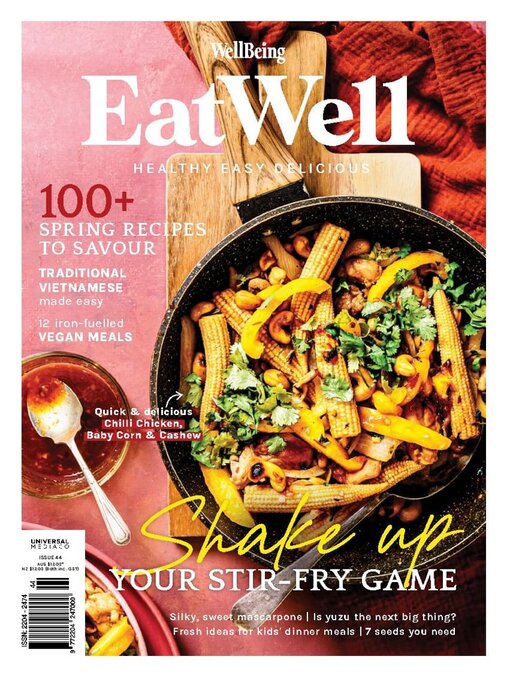A sexy Recipe Mag that has a healthy approach to good food. Taste every page as you flick through – delicious! Why bother? Because everything in here is good for you, easy, and yum. We know you are busy so we give you everything you need to eat well – recipes, shopping lists, quick ideas. You’re tapping in to a heap of wisdom from passionate chefs, bloggers and caring home cooks. You can share yours too – we’re a community. Life’s short…. outsource your food plan to people who love healthy good food. If you stopped buying recipe mags years ago because they’re full of things you can’t eat – then try Eat Well! Over 70 recipes per edition. Purchase includes the Digital Edition and News Service. Please stay in touch via our Facebook Page.
Lychees • Lychees Originated in southern China but were brought to Australia more than 100 years ago by Chinese goldminers. They are a tropical fruit so most are grown in Queensland, but they also grow well in northern New South Wales. Lychee trees produce both male and female flowers so are self-pollinating, with the fruit produced in Australia from October through to April. Lychees are best eaten fresh and make a delightful, cleansing post-meal snack, a perfect addition to fruit salads, or they can be used in sweet and sour dishes.
Chrysanthemum greens • Edible chrysanthemum plants are very similar to the ornamental flowering plant you may have in your garden. The leaves and stems are popular in Asian cooking and have a variety of uses. Sometimes labelled as "crown daisy”, if the greens are young and fresh you can enjoy them raw in salads. Beware, however, because older plants are too bitter to be eaten raw, so only use greens that have stalks no wider than three millimetres if eating raw. The most common way to eat chrysanthemum greens is lightly steamed. It will take no more than 30 seconds to steam your greens and they will add a mildly grassy and herbaceous flavour with a satisfying crunch to stews and casseroles. A classic Japanese recipe is to combine cooked chrysanthemum greens with a dressing made from tahini, mirin, soy sauce, rice vinegar and dashi.
from the EDITOR
Eat Well
Our Chefs
Otai • Otai is an invigorating drink for spring and summer that originated in Polynesian islands such as Tonga, Samoa, Hawaii and Fiji. Originally, the mixture was placed in sealed empty coconut shells and left to chill and set in cold streams or behind waterfalls. Otai is definitely best when ice cold, but if you don't have a waterfall handy, just add lots of ice! A basic modern recipe for otai includes a half watermelon, one can of crushed pineapple, three cups of cold water, a can of coconut milk and sugar (if you need it, but you won't!). To make it is easy — just shred (don't blend) the watermelon with a fork and place it into a bowl. Add the other ingredients including the juice from the pineapple and enough crushed ice to be at least one third of the entire mix. Simply chill and then serve. The key is to shred and not blend the fruit; it's said that if you have made otai properly, you can drink the first half from your glass and then eat the second half with a spoon.
Blueberries (Vaccinium spp.) • Blueberries are packed with antioxidants but are also a delicious snack.
NICE TO MEET yuzu • With its delicious tang and fresh, citrusy aroma, yuzu brings an exquisite twist to drinks, marinades, desserts and more. Here’s why the unique Asian fruit is set to become the next big thing in our kitchens.
Beautiful BURGERS • The origins of the hamburger are not crystal clear, but we do know that the Romans had a dish called Isicia Omentata made with minced beef, pepper, garum, and wine that is the earliest known precursor of the modern burger. The "hamburg" sausage made an appearance in the 18th century, but the hamburger really belongs to America. The United States Library of Congress...

 Issue 55
Issue 55
 Issue 54
Issue 54
 Issue 53
Issue 53
 Issue 52
Issue 52
 Issue 51
Issue 51
 Issue 50
Issue 50
 Issue 49
Issue 49
 Issue 48
Issue 48
 Issue 47
Issue 47
 Issue 46
Issue 46
 Issue #45 2022
Issue #45 2022
 Issue #44 2022
Issue #44 2022
 Issue #43 2022
Issue #43 2022
 Issue #42 2022
Issue #42 2022
 Issue #41 2022
Issue #41 2022
 Issue #40 2022
Issue #40 2022
 Issue #39 2021
Issue #39 2021
 Issue #38 2021
Issue #38 2021
 Issue #37 2021
Issue #37 2021
 Issue #36 2021
Issue #36 2021
 Issue #35 2021
Issue #35 2021
